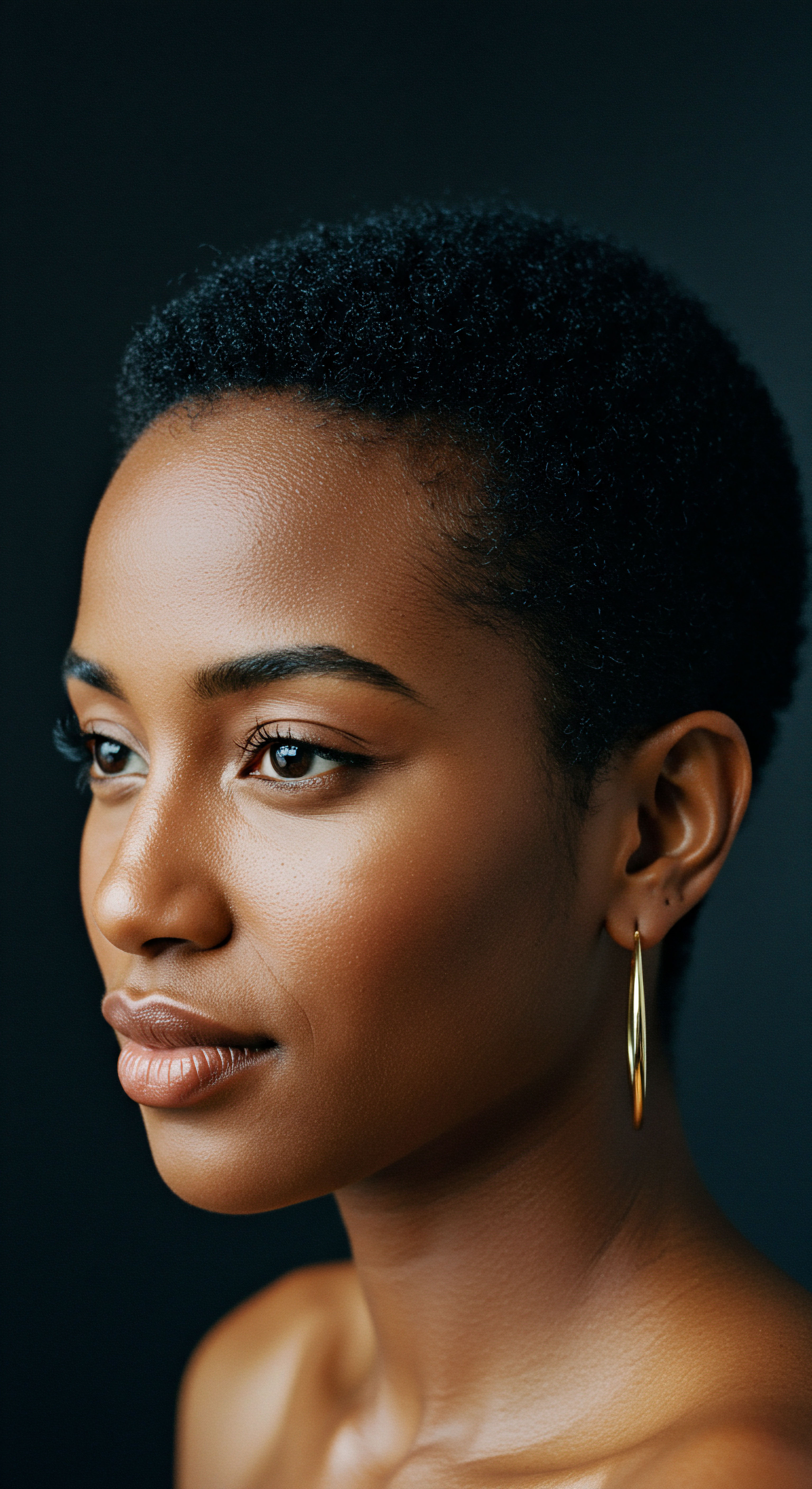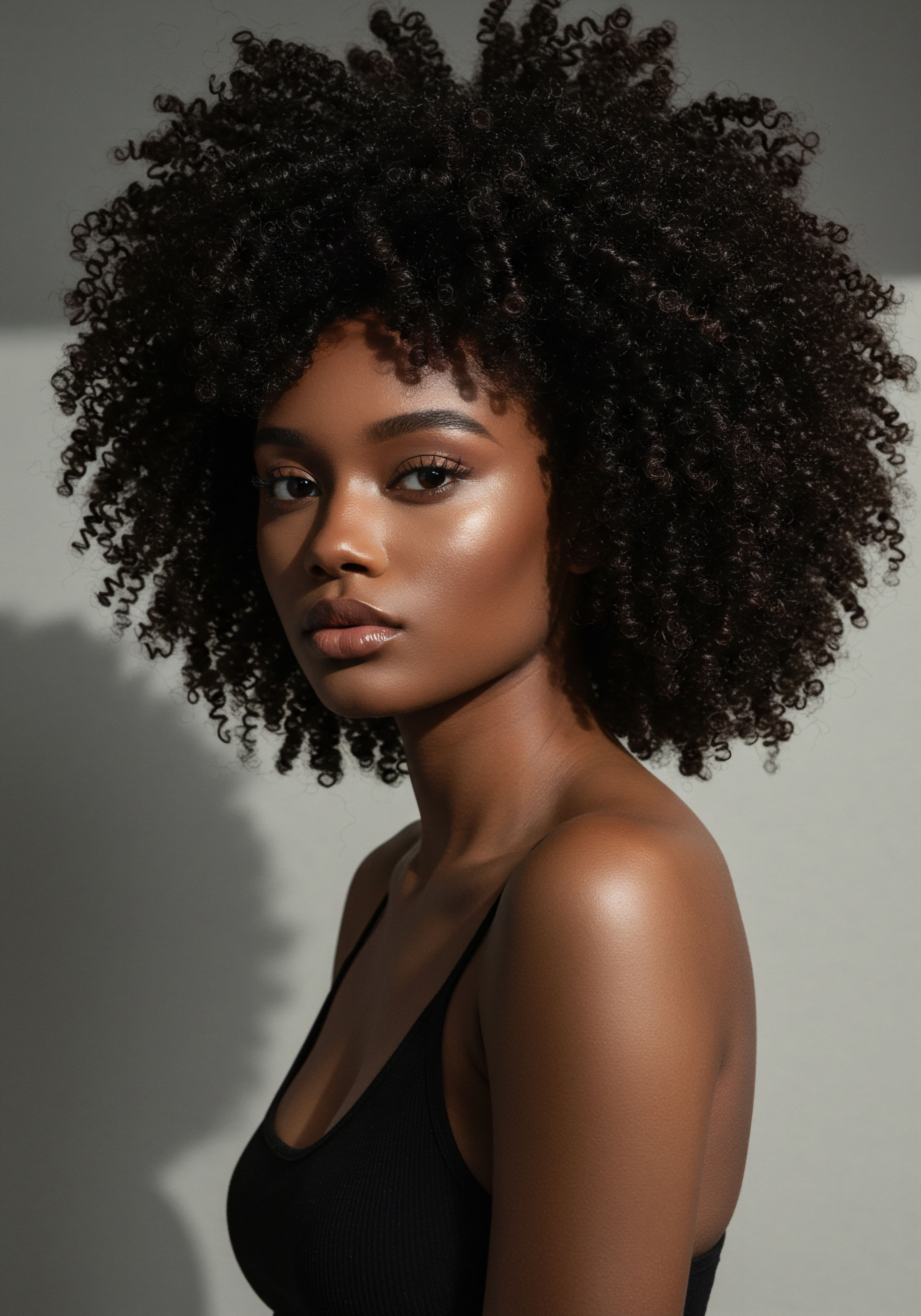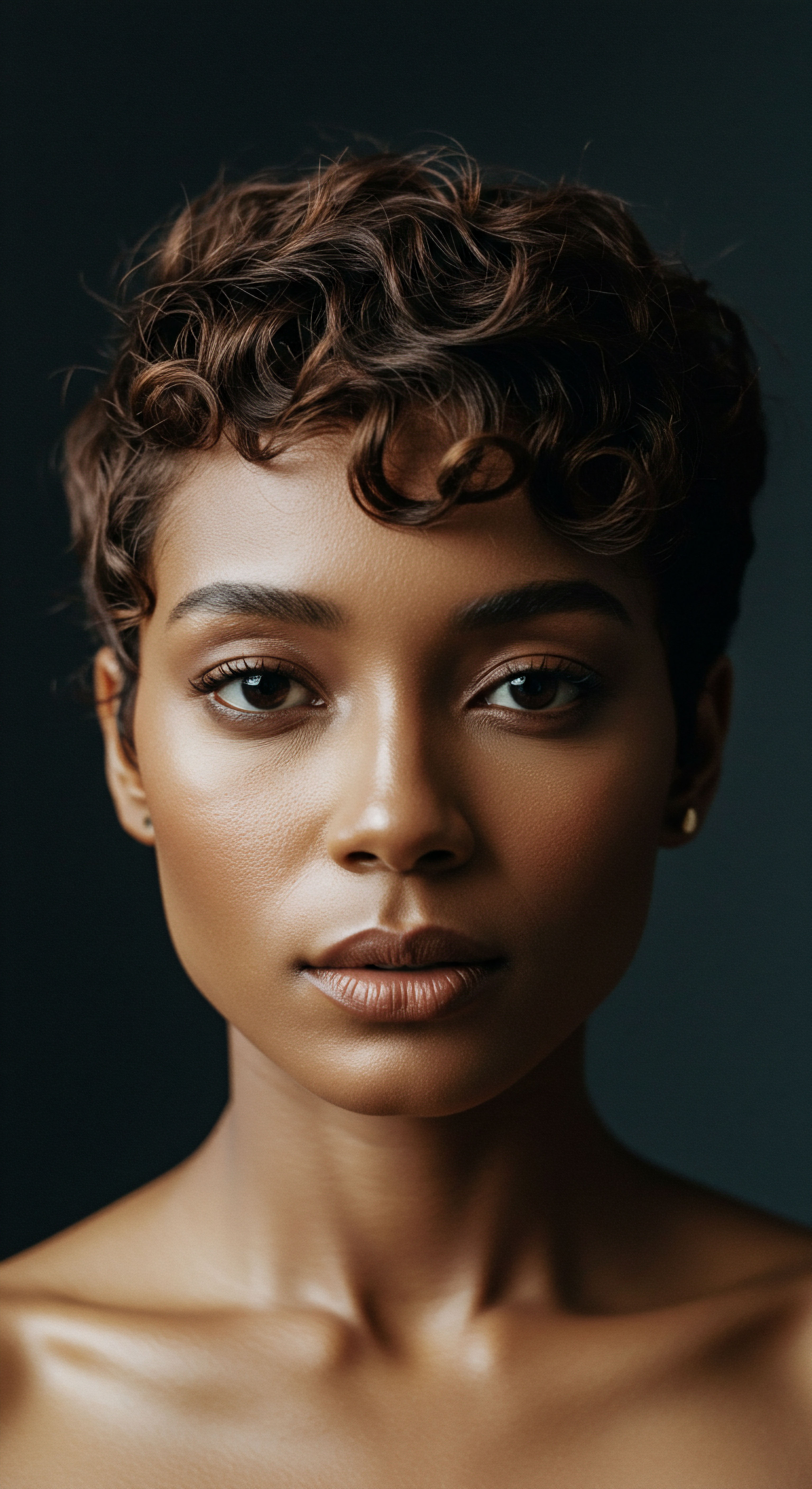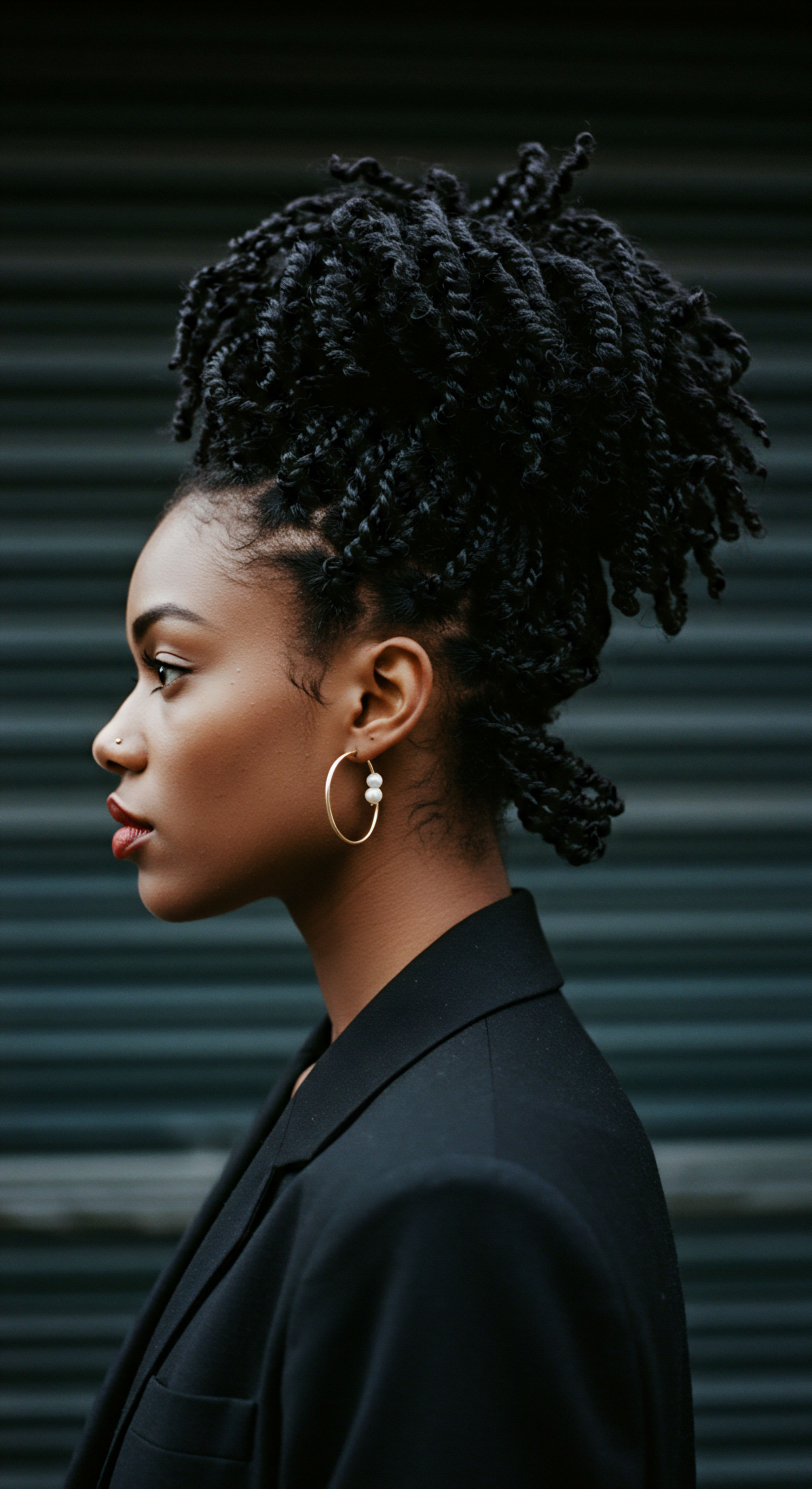
Roots
Our strands hold stories, a quiet testament to lineage and care that stretches back through time. Consider the delicate coil, the resilient curl, the springy zig-zag — each a whisper of ancestral practices, a living archive of ingenuity born from necessity and a deep connection to self. This journey into historical nighttime hair practices offers not just quaint anecdotes, but a profound wellspring of understanding for modern textured hair care. It beckons us to look beyond fleeting trends and commercial promises, toward the enduring wisdom of those who lived in rhythm with their hair, honoring its unique structure and needs long before scientific terms adorned product labels.

Understanding Hair at Its Core
The very composition of textured hair, from its elliptical follicle shape to the distribution of disulfide bonds within its keratin structure, sets it apart. These inherent characteristics contribute to its natural beauty, yet also render it more prone to dryness and breakage compared to straighter hair types. Historically, communities understood this delicate balance, even without microscopes or chemical analyses. Their nightly routines were not merely about appearance; they were about preservation, about tending to the hair’s very life force.
The unique helical twists and turns of a textured strand mean that the natural oils produced by the scalp, sebum, struggle to travel down the hair shaft as readily as they do on straighter strands. This leads to a predisposition for dryness, making moisture retention a paramount concern. Ancient practices often centered on compensating for this natural inclination, ensuring strands remained supple and protected through the sleeping hours.
The intrinsic architecture of textured hair necessitates a historical perspective on its care, recognizing its unique needs for moisture and protection.

Ancient Hair Wisdom and Its Language
Across diverse cultures, hair held immense social and spiritual significance. It was a marker of identity, status, age, and even marital standing. The care given to hair was a ritualistic act, often communal, passing down techniques and knowledge through generations.
The terminology used, though not scientific in our modern sense, conveyed a deep experiential understanding. Words described not just the style, but the intent behind it ❉ to protect, to adorn, to signify.
- Protection ❉ Many historical practices focused on safeguarding hair from environmental elements and mechanical stress.
- Adornment ❉ Hair served as a canvas for self-expression and cultural symbolism, often decorated with shells, beads, or precious metals.
- Signification ❉ Styles communicated social roles, marital status, or even spiritual beliefs within a community.
The communal aspect of hair care in many historical societies also highlights a valuable, often overlooked, dimension ❉ the social and psychological benefits derived from shared grooming rituals. These moments fostered connection, storytelling, and the transmission of practical wisdom.
| Cultural Context Ancient Egypt |
| Associated Meanings Status, Divinity, Wealth |
| Examples of Practice Elaborate wigs, intricate braids with adornments |
| Cultural Context Yoruba People, Nigeria |
| Associated Meanings Community Roles, Identity |
| Examples of Practice Complex braided styles |
| Cultural Context Himba Tribe, Namibia |
| Associated Meanings Connection to Earth, Ancestors |
| Examples of Practice Dreadlocked styles coated with red ochre paste |
| Cultural Context Native American Cultures |
| Associated Meanings Strength, Spirituality |
| Examples of Practice Uncut hair, specific braids |
These traditions remind us that hair care is more than just a physical process; it is a profound connection to heritage and self.

Ritual
As we move from the foundational understanding of hair to its practical applications, we acknowledge the quiet longing for methods that truly serve our strands, beyond the superficial. Daily or periodic hair practices shape not only the appearance of our hair but also our personal sense of wellbeing. Stepping into the realm of historical nighttime rituals for textured hair is akin to finding a comforting, familiar rhythm, a gentle guide to techniques that have stood the test of time. It is here, in the quiet of the evening, that some of the most impactful hair care once occurred, laying the groundwork for resilient, healthy strands.

Why Nighttime Care?
The hours of sleep, often overlooked in modern hair care, present a unique opportunity for restoration and protection. During slumber, hair is vulnerable to friction against bedding, leading to tangles, breakage, and loss of moisture. Historically, recognizing this vulnerability led to the development of ingenious methods to safeguard hair while the body rested. These practices aimed to minimize damage, preserve styles, and allow treatments to deeply work their magic without interruption.
The principle was simple ❉ if hair is protected during its most vulnerable state, its daytime vitality increases. This preventive approach, a cornerstone of ancestral hair care, stands in gentle contrast to modern habits that often prioritize styling over foundational health.
Nighttime care historically served as a shield for textured hair, minimizing friction and maximizing restorative processes during sleep.

Techniques of Preservation
Many historical nighttime practices centered on manipulation that grouped hair together, reducing individual strand exposure and movement. Braiding, twisting, and wrapping were not merely daytime adornments; they were nightly defenses.

The Art of Braiding and Twisting for Sleep
From cornrows laid close to the scalp to larger, looser braids or twists, these techniques served multiple purposes. They kept hair neatly contained, preventing tangles and snags that could lead to breakage. They also helped to maintain moisture, as the grouped strands created a micro-environment that slowed evaporation. Moreover, for those seeking elongated styles, these methods offered a gentle, heat-free way to stretch curls and coils, preparing them for easier styling the next day.
Consider the simple act of creating a few large braids before bed. This reduces the surface area of hair exposed to friction from pillows, a common cause of frizz and mechanical damage. For modern textured hair, this translates directly to less morning detangling, improved definition, and better moisture retention.

Wraps and Head Coverings ❉ A Gentle Cocoon
The use of head coverings, from simple cloths to more elaborate wraps, provided an additional layer of protection. Materials like silk or satin, though perhaps not always explicitly identified as such in ancient times, would have offered a smooth surface that minimized friction. These coverings kept hair compressed and undisturbed, preserving intricate styles and preventing hair from drying out in the night air.
The wisdom here is timeless ❉ a smooth, protective barrier between hair and abrasive surfaces makes a profound difference. Modern textured hair benefits immensely from the use of silk or satin bonnets, scarves, or pillowcases, echoing these historical practices.

Treatments and Application Methods
Nighttime was also a favored time for applying nourishing treatments, allowing them to penetrate deeply without interference from daily activities or environmental stressors.
The selection of substances varied widely by region and available resources, but the intent remained consistent ❉ to condition, strengthen, and support hair vitality.
- Oils and Butters ❉ Natural Emollients such as shea butter, coconut oil, or various plant-derived oils were often massaged into the scalp and strands. These provided essential moisture, sealed the hair cuticle, and imparted a protective sheen.
- Herbal Infusions ❉ Preparations from local plants known for their conditioning or strengthening properties were sometimes applied as rinses or masks, left on overnight to work their magic.
- Clay Masks ❉ Certain mineral-rich clays were used to cleanse and condition the scalp, often applied as a paste and rinsed out in the morning.
These applications were often accompanied by gentle scalp massage, a practice that not only distributed the product but also stimulated blood circulation, which supports follicular health. The prolonged contact during sleep allowed these natural ingredients to fully absorb, delivering maximum benefit. The modern practice of “pre-pooing” with oils or applying deep conditioning treatments overnight directly reflects this ancient wisdom.

Relay
Our current exploration deepens, reaching into the very core of why historical nighttime hair practices hold such potent relevance for modern textured hair care. Here, the currents of science, culture, and personal experience converge, revealing a sophisticated understanding that transcends mere anecdote. We look beyond surface-level techniques to the underlying biological, social, and psychological mechanisms that lend these ancestral methods their enduring power.

What Constitutes Healthy Textured Hair at a Microscopic Level?
To truly appreciate the value of historical practices, we must first comprehend the unique architecture of textured hair. Unlike straight hair, which typically possesses a round cross-section, textured hair strands exhibit an elliptical or even flattened shape. This structural distinction causes the hair to bend and coil as it grows, creating its characteristic curl pattern.
At the microscopic level, the cuticle, the outermost protective layer of the hair shaft, is often more lifted and less tightly packed in textured hair, making it more susceptible to moisture loss and external damage. Furthermore, the points where the hair strand bends are inherently weaker, making it more prone to breakage under stress.
The chemical bonds within the hair, particularly the disulfide bonds, play a significant role in determining curl pattern. In textured hair, these bonds are unevenly distributed, contributing to the hair’s unique shape and its tendency to be drier and more fragile. Understanding these fundamental aspects of hair biology is paramount to appreciating how historical protective measures were, in essence, early forms of applied hair science.

Can Daily Friction Undermine Hair Health?
One of the most significant yet often underestimated threats to textured hair health is mechanical friction, particularly during sleep. When hair rubs against abrasive surfaces like cotton pillowcases, the lifted cuticles are further disrupted, leading to frizz, tangles, and ultimately, breakage. This cumulative damage, though seemingly minor each night, can significantly compromise hair length retention and overall vitality over time.
Consider the widespread issue of Traction Alopecia, a form of hair loss caused by prolonged or repeated tension on the hair follicles. While often associated with tight styling, the constant pulling and rubbing of unprotected hair against bedding contributes to this mechanical stress. A study published in ResearchGate, analyzing data from African schoolgirls and women, reported a prevalence of traction alopecia (TA) of 17.1% in schoolgirls (ages 6-21) and 31.7% in women (ages 18-86). The research highlighted that the odds of TA were higher in adults and significantly increased when traction was applied to chemically processed hair.
This stark data point underscores the vulnerability of textured hair to mechanical stress, whether from tight braids or nightly friction. The historical use of smooth coverings and contained styles during sleep directly addressed this pervasive issue, offering a preventive measure against such follicular strain.
| Vulnerability Dryness |
| Scientific Explanation Elliptical shaft limits sebum distribution, lifted cuticle allows moisture escape. |
| Historical Nighttime Practice Oiling, butter application, wraps. |
| Vulnerability Breakage |
| Scientific Explanation Coil bends are weak points, friction causes cuticle damage. |
| Historical Nighttime Practice Braiding, twisting, smooth head coverings. |
| Vulnerability Traction Stress |
| Scientific Explanation Repeated pulling on follicles, exacerbated by friction. |
| Historical Nighttime Practice Loose contained styles, protective headwear. |

The Biochemical Impact of Traditional Treatments
Beyond mechanical protection, many traditional nighttime applications involved natural ingredients with demonstrable biochemical benefits. Plant-derived oils, butters, and herbal concoctions were not chosen arbitrarily; their properties aligned with the hair’s fundamental needs.

How Do Natural Oils Aid Hair Structure?
The use of oils like coconut oil or shea butter before bed served as more than just a cosmetic enhancement. Coconut oil, for instance, has a molecular structure that allows it to penetrate the hair shaft, reducing protein loss from washing and conditioning. Shea butter, rich in fatty acids and vitamins, forms a protective barrier on the hair surface, sealing in moisture and reducing water evaporation.
These emollients coat the hair, smoothing the cuticle and reducing friction between individual strands, thereby minimizing breakage during sleep. The prolonged contact during nighttime application maximizes the absorption and effectiveness of these beneficial compounds.
The practice of massaging these substances into the scalp also played a role in scalp health. While not always explicitly understood in ancient times, stimulating the scalp can promote blood flow to the hair follicles, potentially supporting nutrient delivery and waste removal, both vital for healthy hair growth.

The Psychological and Social Dimensions of Nightly Rituals
The benefits of historical nighttime hair practices extended beyond the purely physical. The very act of engaging in a routine, particularly one connected to self-care, carries significant psychological weight.
For women of African descent, hair has long been intertwined with identity, self-expression, and societal perception. The consistent care of textured hair, often a labor of love, can be a grounding experience. Research indicates that personal grooming rituals, including hair care, can provide structure and a sense of control, particularly during times of uncertainty or stress. The intentional application of products, the feeling of textures, and the sensory experience can induce mindfulness, reducing stress hormones and promoting feelings of calm.
Historically, these nighttime rituals were often communal, shared among women in families or communities. This collective act of care reinforced social bonds, transmitted cultural knowledge, and provided a space for shared experiences and support. This social aspect, while less common in individualistic modern societies, offers a powerful reminder of the holistic benefits derived from these practices. The quiet, personal time spent on hair before sleep can still serve as a meditative pause, a moment of connection to oneself and, by extension, to a rich cultural legacy of care.

Reflection
As we close this exploration, the echoes of ancient wisdom resound with quiet clarity, offering a gentle invitation to reconsider our modern approach to textured hair care. The threads of history, science, and cultural practice are not disparate elements, but rather an interconnected whole, revealing that the simplest, most mindful acts often hold the deepest power. What began as necessity in ancestral homes has proven to be a blueprint for vitality, a testament to the enduring resilience of textured strands when treated with profound understanding and respect.
The insights gleaned from historical nighttime hair practices are not about reverting to the past entirely, but about drawing forth its timeless lessons. They encourage us to slow down, to listen to our hair’s whispers, and to honor its unique requirements for protection and nourishment, particularly during the restorative hours of sleep. It is a gentle reminder that genuine care extends beyond quick fixes or superficial shine, reaching into the very heart of what it means to truly nurture our crowns.
May we carry forward this heritage of thoughtful tending, allowing the wisdom of yesterday to illuminate the path to healthy, vibrant hair today and for generations to come.

References
- Khumalo, N. P. et al. “Determinants of marginal traction alopecia in African women.” Clinical, Cosmetic and Investigational Dermatology, 2013.
- Davis-Sivasothy, Audrey. The Science of Black Hair ❉ A Comprehensive Guide to Textured Hair Care. Sivasothy, 2011.
- Banks, Ingrid. Hair Matters ❉ Beauty, Power, and Black Women’s Consciousness. New York University Press, 2000.
- Byrd, Ayana D. and Lori L. Tharps. Hair Story ❉ Untangling the Roots of Black Hair in America. St. Martin’s Press, 2001.
- Sherrow, Victoria. Encyclopedia of Hair ❉ A Cultural History. Greenwood Press, 2006.
- Patton, Tracey Owens. “Hey Girl, Am I More Than My Hair?” Communication Studies, 2006.
- Thompson, Cheryl. Black Women and Identity ❉ What’s Hair Got to Do With It? University of Michigan, 2008.
- Gavazzoni Dias, Maria Fernanda Reis. “Hair Cosmetics ❉ An Overview.” International Journal of Trichology, 2015.
- Wood, Miranda, and Melissa Leyden. “Chemistry of Wellness ❉ Hair and Hair Care.” UVA ChemSciComm, 2023.
- Powell, Margaret K. and Joseph Roach (Eds.). A Cultural History of Hair in the Age of Enlightenment. Bloomsbury Academic, 2021.
- Akanmori, Patience. “The Grooming of Hair and Hairstyling as a Socio-Cultural Practice and Identity ❉ A Deprivation Africans Went Through During Slavery.” International Journal of Arts and Humanities, 2015.
- Ogiri, N. O. “Visual Documentation of Traditional Nigerian Hair Styles and Designs as a means of expressing Social and Cultural Heritage through Photography.” Global Journal of Arts Humanities and Social Sciences, 2015.
- Olakunle, O. S. & Olowoselu, A. A. “A Community-Based Study of Hair Care Practices, Scalp Disorders and Psychological Effects on Women in a Suburban Town in Southwest Nigeria.” ResearchGate, 2023.
- Sivakumaran, P. & Ramani, P. “Influence of hairdressing on the psychological mood of women.” Journal of the Society of Cosmetic Chemists, 2000.
- Stiles, Diamond. “Natural Hair Care Rises as Empowering Self-Care Ritual.” Howard University News Service, 2024.